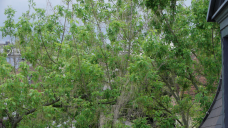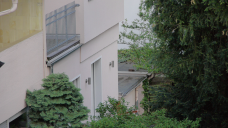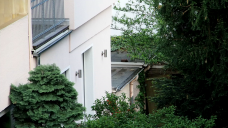
It allows to keep PV going, with more focus towards AI, but keeping be one of the few truly independent places.
-
The OM-D is awesome but its not cutting it for video at the moment. Not until it records with higher bit rate. Sure enough there are subjects that require no high bit rate. So you could already shoot a movie with a RED Epic or Alexa style dynamic range. Well exposed faces and still retain textured clouds in the background.
E-M5 from a video point of view:
the good
- high DR
- strong IS with native m43 lenses
- seems to have long battery life. Battery situation is much better than with the GH2 (third party compatibility, grip that holds extra batteries - E-M5 should be a perfect option for time lapse)
- the tighter crop makes the vignetting of some great 16mm c-mount lenses disappear (some just fail to cover the over sized sensor of the GH2)
the bad
- low bit rate
- 30fps only
- no IS for non m43 lenses in video mode
- no focus assistant for non m43 lenses (zoom in mode)
- no access to manual controls during recording (my experience)
- guides and histogram disappear while recording
-
@Alex
and... if use adapter m4/3 with chip, is possible works IS for non m43 lenses in video mode?here chips to m4/3: http://store.tagotech.com/product_info.php?cPath=22_80&products_id=526
Other solution: Hacking this inconveniences. :-)
-
The problem with people nowadays is that they use photographic camera's to compete and compare with video cameras. Come on guys, thats a really pointless exercise, the OM-D is a photographic camera that adds extra video capabilities. RED? Are you kidding me? Black magic and good Sony's are there for the grab, 3000$, each tool has its place, the OM-D is a photographic excelent one and we have excelent choices on the Sony and Blackmagic camp. The OM-D and GH2(+14-140) kit stands for a nice 2000$, and they share lenses, so enjoy each tool for what they were meant to. "The Bad"? be realistic Alex.
We have a pretty good system to work with, each to its own.
-
Fair argument @original_joao but the times have changed. Apple has kind of the push the bar when we talk about personal gadgets. If a phone (iphone and nokia pureview) could take quality pictures and videos then the dedicated cameras have to push the bar higher to just basically survive.
The sensor in m43 still cameras is same as af100 so why not give the enduser all the features (higher bitrates) and create a killer product.
The marketing guys should not make decisions and let the company geeks decide on features.
Bill Gates, Steve Jobs, Woz are the reason everyone in this world owns a pc otherwise it could have only be owned by elites.
-
Because your needs are not the same. My family is 3 generations on Video and Photography, i'm a photographer my father a video guy and we have different needs for tools. For me the ergonomics of the OMD with Grip are killer not so for video. A good shoulder design is a must for video, you can't make everyone happy, but like you say, like Apple build one tool for each job. MP3 = IPOD Phone = IPhone Laptop = MacBookPro etc....
you don't see Apple building only one product. You already have the product you search, its called BlackMagic. A camera built for video/movies not stills.
In a perfect world you would have a stills/Video/Cinema camera with a 10-300mm f 1 lens with a 35mm killer sensor, but the world is just what it is, Real.
Regards.
-
@Alex or anyone else with the EM5, just curious how the field of view is affected when going from still photos to video mode. With all olympus m43 bodies they have a standard 4:3 ratio sensor, so cropping is enevitable when doing 16:9, but is there extra being cropped?
The test:
shoot a still photo
shoot video at the same location
See if and how much the horizontal resolution is affected.
I have a hunch that the amount of change isn't enough for a strictly software based IS, but I could be wrong.
-
@joesiv
here see test: http://i.imgur.com/Tj98b.jpgbetter comparative: http://i.imgur.com/fy0i5.jpg
-
Getting the most out of the Olympus E-M5
http://www.dpreview.com/articles/9115179666/user-guide-getting-the-most-out-of-the-olympus-e-m5
-
@cocute, thanks cocute, that's pretty much what I suspected, the horizontal change is quite minimal! I honestly don't think that it could be fully software based. Some similar software based stabalization like on the iphone 4s trim much more to effectively reduce shake.
The crop on the em5 might be similar to the d800, used to get the best pixel ratio for binning/skipping.
-
@Vitaliy_Kiselev thanks for link very interesting guide, many things are not in the manual
-
Wow, what I particularly like about this rainy video is the effectiveness of the image stabilization. You don't really notice the person is walking. You can notice it, but it is minimal.
It is more noticeable when camera movements are a little larger, and the image is stretched in and out near the corners. But that's the deal with wide angle lenses anyway. It would be much worse, I guess, without IS. Would be nice to see a comparison video without Image Stablization.
-
Today, a friend of mine visited who recently bought an EM5 - and since we both own a Panasonic 14mm-140mm lens, we were able to shoot some stuff for comparison side-by-side at the same time.
Bottom line: I wouldn't trade in my GH2 for an EM5.
See below three stills extracted from 1920x1080 video clips. All stills were saved from I-frames.
The first from a cloudy evening outdoor daylight scene (at the same focal length, but only almost the same position). The moving leaves expose compression artifacts from the EM5. Ok, 100MBit/s video vs. 17MBit/s video may not be a fair comparison, but unless the EM5 is hacked, its users won't have a better choice.
The second is extracted from an indoor low-light shot, with very little light coming from one window. The GH2 shot was taken at ISO 12800. While of course it's noisy, you can still recognize the book shelf and read some titles. The EM5 did not allow to choose such a high ISO for video, so it's severely underexposed, and any details gone into the black void.
The third is extracted from a shot to a region with high contrast - a bright wall of a house, just besides some dark garden trees. No motion was involved, so the EM5 does not suffer from compression artifacts. But in the EM5 material, there is clearly too much contrast, so the dark regions and highlights are lacking detail, and the house wall (which is actually colored a little pink) looks too white. The EM5 shot is also sharpened a lot, too much for my taste. Maybe some option settings my friend did not try yet would allow for a "flatter" image with the EM5.
Regarding non-video still images: The RAW-to-JPEG conversion of the EM5 clearly applies more reasonable defaults, so its JPEGs look somewhat better. But in the RAW format comparison, the results from the GH2 looked as good or even better than those of the EM5, especially at low ISO values. At high ISO values, the EM5 was very slightly better. (The output of RawTherapee from the .RW2 files looked awesome in comparison to the JPEGs the GH2 had written, while the best results I could get from the .ORW files off the EM5 looked like the JPEGs the EM5 had also written, which means the EM5 did a better job of in-camera processing, but does not really have a significantly better sensor than the GH2.)
I understand that some people highly value the weather-sealing of the EM5, or particulary like its higher resolution display. But to me it's more relevant that the GH2 has a fully articulating display, and that it has a built-in flash for the few occasions that I need such for documentary reasons. I would miss both a lot with the EM5. And I am ok with a non-weather-sealed plastic body (that is 20g lighter than the EM5) especially since I need to buy an expensive underwater-housing, anyway.

 still_from_low_light_video_em5.png1920 x 1080 - 247K
still_from_low_light_video_em5.png1920 x 1080 - 247K
 still_from_video_em5.png1920 x 1080 - 3M
still_from_video_em5.png1920 x 1080 - 3M
 still_from_low_light_video_gh2.png1920 x 1080 - 3M
still_from_low_light_video_gh2.png1920 x 1080 - 3M
 still_from_video_gh2.png1920 x 1080 - 4M
still_from_video_gh2.png1920 x 1080 - 4M
 still_from_video_dr_gh2.png1920 x 1080 - 2M
still_from_video_dr_gh2.png1920 x 1080 - 2M
 still_from_video_dr_em5.png1920 x 1080 - 2M
still_from_video_dr_em5.png1920 x 1080 - 2M -
Olympus OM-D E-M5 Shooter's Report
http://www.imaging-resource.com/PRODS/omd-em5/omd-em5A.HTM#SR
-
A dynamic range comparison (still image)
http://admiringlight.com/blog/olympus-e-m5-vs-panasonic-gh2-dynamic-range-battle/
-
How "admiringlight.com" can claim that his test is one of dynamic range is completely beyond me, as are his resulting conclusions.
You tell a camera what region it should meter exposure for (as in e.g. "spot" or "whole image"), and if the camera metering does the right thing, it will choose ISO/aperture/shutter such that the RAW values read out from the sensor will be zero for the darkest part of your region of interest and 4095 (2^12-1, assuming 12 bit per channel) for the brightest pixels in your region of interest, with hopefully 4094 reasonably spread and well distinguishable levels in between.
Now if you voluntarily increase or decrease the exposure value, more pixels than before will have either zero or 4095 as their readout value, causing some loss of information in either the dark or the bright regions, in exchange for providing somewhat more accuracy for the reproduction of the remaining non-clipped pixel values.
If a cameras metering is such that by default, it does not make use of the whole value range the sensors analog-to-digital converters could provide, this means the camera spoils some of the accuracy it could reproduce colors with. And of course, if a camera does so, it will lose less details if the image is voluntarily, at the users request, over or under exposed - in exchange for losing accuracy for every shot.
The "admiringlight.com" test setup punishes a camera for optimal metering, and favors cameras doing less than optimal metering.
By no means, this is a test of dynamic range. For testing that, you only need one correctly exposed image that has a grey scale from very dark black to very bright white in it, so you can measure how many different shades of grey the sensor can distinguish over which range of darkness/brightness.
-
@karl I'm not sure what you're talking about. The site metered with one camera, and then set both cameras (in manual) to the exact same settings, with exception to ISO which 160 was selected for GH2 and 200 was set for EM5 (both the native ISO's). He noted that viewing the images after on the computer showed gray point to be pretty much identical.
I'm not sure how this is unfair as both cameras are getting the same amount of light, and he tested both highlights and shadows from the same image. The EM5 was better in both ends, so even if he were to expose darker for the GH2, the shadows would have been even worse.
-
@joesiv: The point is that his whole "measurement" was based on voluntarily over- and under-exposed images:
I chose a high DR area, and then decided to see how they did when overexposed 3 stops and pulled back, and underexposed 3 stops and pushed back.
... and that makes this a test of how much of the sensor value range is utilized by the cameras default metering, but not a test of DR.
I am not saying that the EM5 does not have a larger dynamic range for still images than the GH2, there have been grayscale tests (like the ones from dpreview) which indicate that. But the admiringlight.com test does not measure that.
-
The guy is a bit of a cheat, there is no histo data that would be important to see and easily done from LR(which he used) to show how blown the em5 was c/w gh2. Again, maybe the em5 does have better dr but the iso of OMD seems suspect to me and the real value is closer to 100(like the pen's) also has iso200 base and was tested to iso130 by dxo. Why do this? easy, so that all iso's look a stop better than they are further up, so iso400 of OMD is really iso800 of GH2 etc etc.
Howdy, Stranger!
It looks like you're new here. If you want to get involved, click one of these buttons!
Categories
- Topics List23,992
- Blog5,725
- General and News1,354
- Hacks and Patches1,153
- ↳ Top Settings33
- ↳ Beginners256
- ↳ Archives402
- ↳ Hacks News and Development56
- Cameras2,367
- ↳ Panasonic995
- ↳ Canon118
- ↳ Sony156
- ↳ Nikon96
- ↳ Pentax and Samsung70
- ↳ Olympus and Fujifilm101
- ↳ Compacts and Camcorders300
- ↳ Smartphones for video97
- ↳ Pro Video Cameras191
- ↳ BlackMagic and other raw cameras116
- Skill1,960
- ↳ Business and distribution66
- ↳ Preparation, scripts and legal38
- ↳ Art149
- ↳ Import, Convert, Exporting291
- ↳ Editors191
- ↳ Effects and stunts115
- ↳ Color grading197
- ↳ Sound and Music280
- ↳ Lighting96
- ↳ Software and storage tips266
- Gear5,420
- ↳ Filters, Adapters, Matte boxes344
- ↳ Lenses1,582
- ↳ Follow focus and gears93
- ↳ Sound499
- ↳ Lighting gear314
- ↳ Camera movement230
- ↳ Gimbals and copters302
- ↳ Rigs and related stuff273
- ↳ Power solutions83
- ↳ Monitors and viewfinders340
- ↳ Tripods and fluid heads139
- ↳ Storage286
- ↳ Computers and studio gear560
- ↳ VR and 3D248
- Showcase1,859
- Marketplace2,834
- Offtopic1,320
Tags in Topic
- olympus 121
- mft 47
- professional 8
- retro 5
- olympus-d 2









